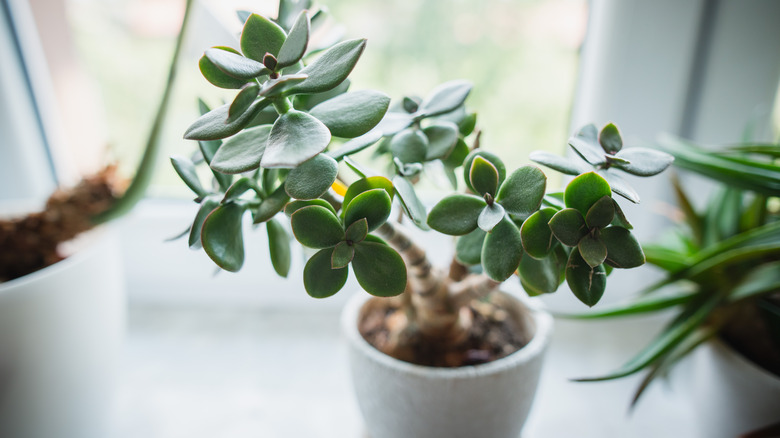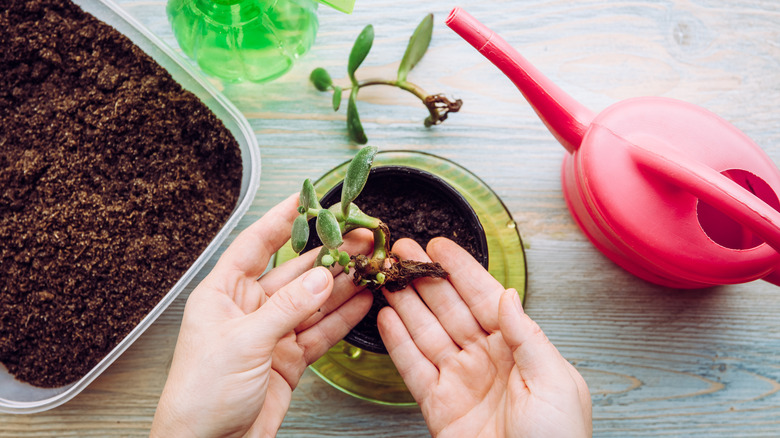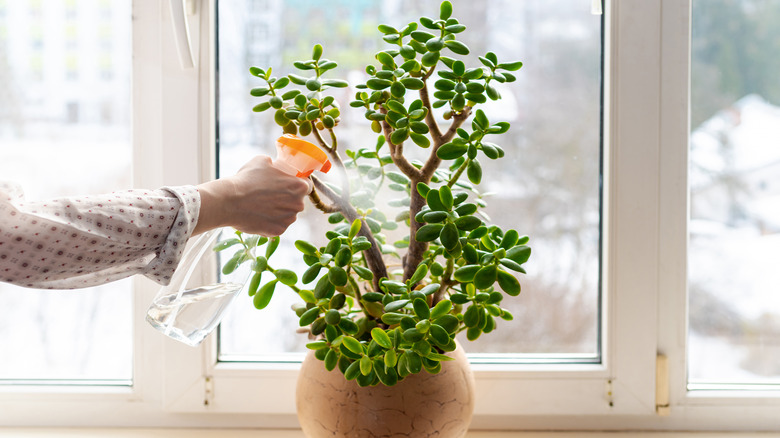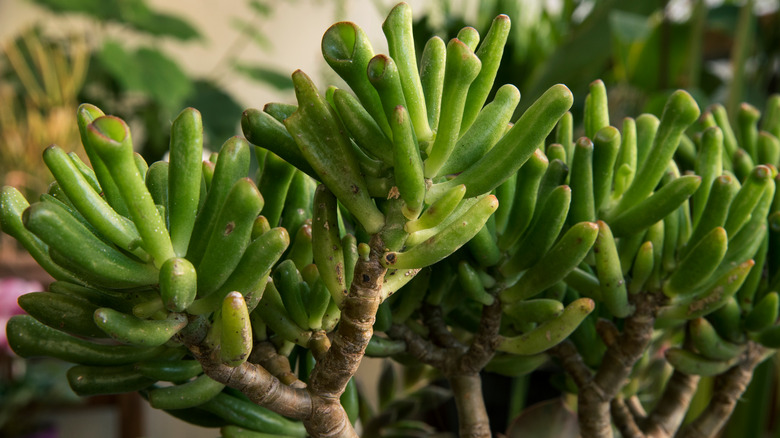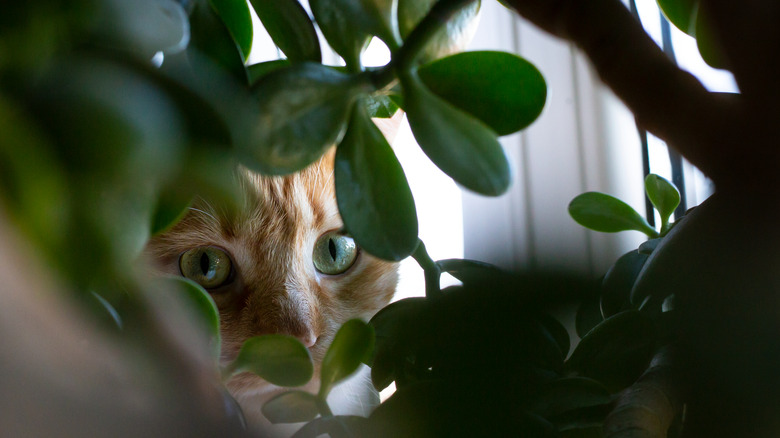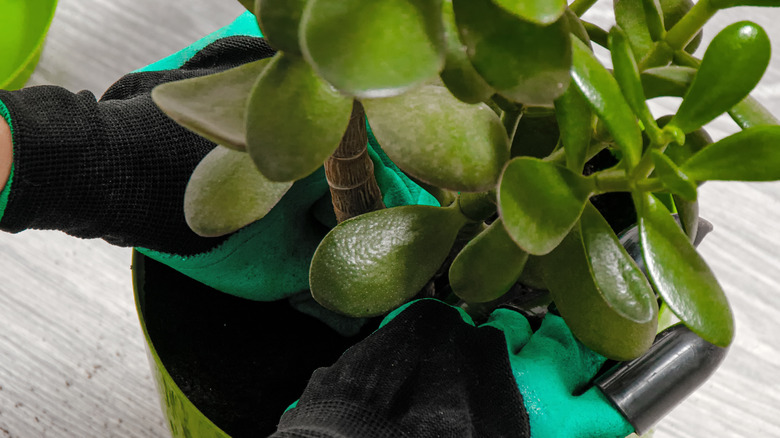How To Successfully Care For A Jade Plant
Jade plants are some of the most popular succulents to own and cultivate as houseplants. Their scientific name is Crassula ovata, according to the United States Department of Agriculture, but these plants are more popularly known as friendship plants, lucky plants, and money trees (although "money tree" is also often used to describe another type of plant, the Guiana chestnut, per Nature Perfect). The jade plant's association with money and luck comes from its leaves, which RHS reports are typically between 3 and 9 centimeters long and 2 and 4 centimeters wide and are shaped like green coins or jade gemstones.
It is believed to be good feng shui to keep a jade plant by your door, to invite money and luck into your home, according to Better Homes and Gardens. But beyond myth and legend, there are also scientific benefits to owning and cultivating jade plants. ACS found that jade plants can significantly contribute to removing toxic chemicals such as acetone from your home's air, and an article published by the American Society for Horticultural Science states that jade plants can also increase humidity in indoor spaces — say goodbye to humidifiers!
How to grow jade plants
Jade plants can be propagated, meaning a new plant can be grown from a cutting or even a single leaf from an existing plant. The Spruce explains the propagation process, which begins with first securing a cutting or a leaf from a healthy plant. For a cutting, you want one that is at least 2 to 3 inches long. With a leaf, gently remove it from the plant, making sure you don't separate the leaf from the stem but rather the stem from the branch. Slowly twisting the leaf back and forth until it naturally separates from the plant, instead of tearing it off, can help with this process.
Allow the cutting or leaf to dry out for several days, then dip the end of the cutting or leaf stem in rooting powder. Prepare a potting soil mixture that is equal amounts of soil and soil additive, such as perlite. For a cutting, plant the end of the stem into the soil and water enough to dampen it. For a leaf, simply set the leaf on top of the soil mixture and mist it occasionally. In a few weeks, the cutting will have rooted, and the leaf will have sprouted roots and stems and begun building its own diminutive plant. UConn Home & Garden Education Center notes that for younger jade plants, direct sunlight should be avoided, as these sensitive babies can be easily scorched until they are a little hardier.
How to care for a jade plant
Jade plants are succulents, like cacti, and so the number one rule for keeping a jade plant alive is to not overwater it. Wisconsin Horticulture recommends choosing porous, well-draining soil to keep your plant dry and avoid root rot. If a jade plant is overwatered, its leaves can also start to loosen, so if you brush up against your jade plant and leaves drop, it's a sure sign you're giving it too much water.
Jade plants should be kept in a bright area of your home where they are guaranteed to receive between 4 and 6 hours of indirect sunlight a day. Per The Spruce, jade plants thrive best in temperatures between 65 to 75 degrees during the day, and 50 to 55 degrees at night, which coincides nicely with the temperatures at which most people like to maintain their homes. No wonder these plants are so popular.
Jade plant varieties
The jade plant is part of the Crassula genus, which it shares with about 200 species, according to World Flora Online. While the most common Crassula species is the jade plant, there are a variety of well-known subspecies also in the Crassula genus:
-
Red dwarf jade: With the scientific name Portulacaria afra, red dwarf jade looks similar to a traditional jade plant, except it is shorter and has red leaves, as opposed to the classic jade green. The Spruce reports that if these plants are properly pruned, they can live for a hundred years!
-
Gollum jade: Known as both Crassula ovata "gollum" and Crassula ovata "hobbit," gollum jade has long tube-like leaves. Because of its distinctive appearance, it is also commonly known as spoon jade, E.T.'s fingers, and ogre's ears, according to Houzz.
-
Hummel's sunset: Crassula ovata "hummel's sunset" is one of the largest of the jade plant varieties, often growing into a shrub three feet tall if cultivated outdoors, per RHS.
-
Ripple jade: Gardening Know How reports that this species, formally known as Crassula ovata undulata, is also colloquially known as ripple jade or curly jade because of its twisted leaves. The edges of these leaves are often tipped in purple, a unique attribute among jade subspecies.
-
Silver dollar jade: Crassula arborescens also boasts the nicknames "blue Buddha bush" and "Chinese jade." North Carolina Plant Toolbox describes the silvery, blue-gray leaves that set this variety apart.
Are jade plants toxic?
Despite their popularity, jade plants are toxic to both cats and dogs if ingested. According to ASPCA, swallowing jade plant leaves can cause your fuzzy friend to suffer from vomiting, diarrhea, lethargy, a loss of appetite, and a loss of coordination. The toxicity level is the same for all varieties of jade plants listed above, not just the classic green jade. While your fur baby definitely won't feel so hot after eating jade, jade plant consumption is unlikely to be poisonous enough to actually kill your cat or dog — although you should always call your vet at the first sign of ingestion just to be safe.
Fortunately, jade plants are not toxic to humans in the same way, so you don't need to worry if your toddler stuffs their mouth full of the leaves when you're not looking. However, Hunker reports there have been some cases of mild skin irritation caused by exposure to the sap from a cut jade leaf, so you may want to be careful (and potentially wear gloves) when removing leaves for propagation purposes.
How to repot a jade plant
Jade plants, like most succulents, do not need to be repotted very often. For smaller specimens, they will likely only need transplanting every two to three years, while larger plants can stay in the same pot for four to five years. Keep in mind the risk of overwatering and root rot, and consider using terra cotta or clay pots to reduce the levels of moisture your plant is exposed to. A smaller pot, 4 to 6 inches, will probably be sufficient for most plants.
The Spruce provides an overview of repotting these tiny green beauties, which begins with making sure the plant's soil is completely dry. Use a flat edged tool like a table knife to separate the dirt from the inside of the pot, which will help remove any roots that might be stuck to the wall of the pot. Remove the plant from the pot and shake off extra dirt. You can take this opportunity, while the roots are exposed, to trim any roots that appear to be rotting or dead and to apply fungicide to any root cuts to prevent infection and illness. Place the plant in the new, larger pot, and fill in gaps with a potting soil specifically designed for succulents. Keep the plant dry in its new pot — don't water it for at least a week, again, in the hopes of preventing root rot. Place it in a bright area and watch your little luck plant thrive.
